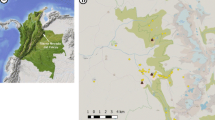Abstract
A survey of plant biodiversity and ethnobotanical studies was conducted in southern Ethiopia using an integrated approach of botanical collections, group discussions, interviews and questionnaires. Species richness, growth forms and uses of native wild plants are described. Borana pastoralists distinguished and named 86% of the plant species identified. A total of 327 plant species distributed among 197 genera and 69 families are documented: 40% are trees/shrubs, 30% forbs (non-woody plants other than grasses and sedges), 16% grasses, 10% climbers, 2% sedges and 2% succulents. Based on richness of species and usefulness, the most important families are Poaceae, Fabaceae, Lamiaceae and Asteraceae. Two hundred forty-eight species (76%) are used by Borana pastoralists, out of which 42% have multiple uses. Indigenous knowledge of pastoralists on use and management of their plant resources is a valuable source of information for conservation and sustainable utilization of the plant biodiversity and, hence, conservation based on indigenous knowledge is recommended.
Similar content being viewed by others
Literature Cited
Abbink, J. 1995. Medicinal and ritual plants of the Ethiopian southwest: An account of recent research. Indigenous knowledge and Development Monitor 3(2). Retrieved on June 1, 2004 from http:// www.nuffic.nl/ciran/ikdm/3-2/articles/abbink.html.
Abebe, D. 1996. The development of drug research. Ethiopian Health and Nutrition Research Institute (EHNRI) News Letter 1:5–6.
Amare Getahun. 1974. The role of wild plants in the native diet in Ethiopia. Agroecosystems 1:45–56.
ARC (Agricultural Research Corporation). 2004. Gum Arabic Research program. Retrieved on June 02, 2004 from http://www. arcsudan.org/gumarabic.htm.
Bassi, M. 2003. Synthesis of lessons learned. Enhancing equity in the relationship between protected areas and local communities in the context of global change. Horn of Africa and Kenya. Retrieved on September 10, 2003 from the internate: http://www. iucn.org/themes/ceesp/Publications/ TILCEPA/CCA-MBassi.pdf.
Coe, F. G., andG. J. Anderson. 1999. Ethnobotany of the Sumu (Ulwa) of southern Nicaragua and comparison with Miskitu plant lore. Economic Botany 53(4):363–386.
Coppock, D. L. 1993. Vegetation and pastoral dynamics in the southern Ethiopian rangelands: Implications for theory and management. Pages 42–61 in R. H. Behnke, I. Scoones and C. Kerven, eds., Range ecology at disequilibrium. New models of natural variability and pastoral adaptation in African savannas. Overseas Development Institute, London, UK.
Cotton, C. M. 1997. Ethnobotany. Principles and applications. John Wiley & Sons, Chichester, UK.
Cunningham, A. B. 2001. Applied ethnobotany. People, wild plant use and conservation. World Wildlife Fund (WWF), UK and USA.
DeWalt, S. J., G. Bourdy, L. R. C. de Michel, andC. Quenevo. 1999. Ethnobotany of the Tacana: Quantitative inventories of two permanent plots of northern Bolivia. Economic Botany 53(3):237–260.
Edwards, S., M. Tadesse, andI. Hedberg, eds. 1995. Flora of Ethiopia and Eritrea. Vol. 2, part 2. Addis Ababa, Ethiopia; Uppsala, Sweden.
Edwards, S., S. Demissew, andI. Hedberg, eds. 1997. Flora of Ethiopia and Eritrea. Vol. 6. Addis Ababa, Ethiopia; Uppsala, Sweden.
FAO (Food and Agriculture Organization of the United Nations). 2003. Olibanum (frankincense), myrrh and opopanax, resins and oils. FAO, Rome, Italy. Retrieved on September 6, 2003 from http:// www.fao.org/docrep/V5350e/V5350e 11 .htm.
Gemedo-Dalle, T. 2004. Vegetation ecology, rangeland condition and forage resources evaluation in the Borana lowlands, southern Oromia, Ethiopia. Ph.D. dissertation, Georg-August University Goettingen, Germany.
Gemedo-Dalle, T., B. L. Maass, and J. Isselstein. (n.d.) Woody plants encroachment and its impact on livestock production in the semi-arid Borana lowlands, southern Oromia, Ethiopia. Submitted to Journal of Arid Environments.
Hedberg, I., andS. Edwards, eds. 1989. Flora of Ethiopia. Vol. 3. Addis Ababa, Ethiopia; Uppsala, Sweden.
—, and —, eds. 1995. Flora of Ethiopia and Eritrea. Vol. 7. Addis Ababa, Ethiopia; Uppsala, Sweden.
Holmgren, P. K., N. H. Holmgren, and L. C. Barnett, eds. 1990. Index herbariorum. Part 1: The herbaria of the world. Regnum Vegetabile [series].
Jin, C., S. Yin-Chun, C. Gui-Qin, andW. Wen-Dun. 1999. Ethnobotanical studies on wild edible fruits in southern Yunnan: Folk names, nutritional value and uses. Economic Botany 53(1):2–14.
Laird, S. A., andF. Noejovich. 2002. Building equitable research relationships with indigenous peoples and local communities: Prior informed consent and research agreements. Pages 179–220 in S. A. Laird, ed., Biodiversity and traditional knowledge. Equitable partnerships in practice. World Wildlife Fund (WWF), UK and USA.
Luoga, E. J., T. F. Witkowski, andK. Balkwil. 2000. Differential utilization and ethnobotany of trees in Kitulanghalo forest reserve and surrounding communal lands, eastern Tanzania. Economic Botany 54(3):328–343.
Omondi, F., and O. B. Jenkins. 1996. The Borana of Ethiopia and Kenya. Retrieved on September 10, 2003 from http://www.geocities.com/orvillejenkins/ profiles/borana.html.
Rossato, S. C., H.de F.Leitão-Filho, andA. Begossi. 1999. Ethnobotany of Caicaras of the Atlantic forest coast (Brazil). Economic Botany 53(4):387–395.
Turner N. J., M. B. Ignace, andR. Ignace. 2000. Traditional ecological knowledge and wisdom of aboriginal peoples in British Columbia. Ecological Applications 10:1275–1287.
Zemede A., andM. Tadesse. 2001. Prospects for sustainable use and development of wild food plants in Ethiopia. Economic Botany 55(1):47–62.
Author information
Authors and Affiliations
Corresponding author
Rights and permissions
About this article
Cite this article
Gemedo-Dalle, T., Maass, B.L. & Isselstein, J. Plant biodiversity and ethnobotany of Borana pastoralists in Southern Oromia, Ethiopia. Econ Bot 59, 43–65 (2005). https://doi.org/10.1663/0013-0001(2005)059[0043:PBAEOB]2.0.CO;2
Received:
Accepted:
Issue Date:
DOI: https://doi.org/10.1663/0013-0001(2005)059[0043:PBAEOB]2.0.CO;2




